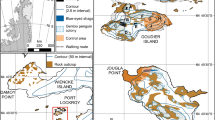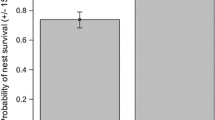Abstract
Petermann Island (65°10′S, 64°10′W), one of the Antarctic Peninsula’s most frequently visited locations, is at the epicenter of a rapid shift in which an Adélie penguin dominated fauna is becoming gentoo penguin dominated. Over the course of five seasons, the breeding productivity of Adélie and gentoo penguins breeding at Petermann Island were monitored to identify drivers of this rapid community change. The impact of tourist visitation on breeding success was also investigated. Consistent with larger trends in this region, the Adélie penguin population decreased by 29% and the gentoo penguin population increased by 27% between the 2003/2004 and 2007/2008 seasons. Reproductive success among Adélie penguins ranged from 1.09 to 1.32 crèched chicks/nest, which was higher than or comparable to other sites and is an unlikely explanation for the precipitous decline of Adélie penguins at Petermann Island. Whereas gentoo penguin reproductive success was lowest in colonies frequently visited by tourists, Adélie penguin colonies frequently visited by tourists had higher reproductive success than those visited only occasionally. These results are placed in the context of other studies on reproductive success and the impact of tourist visitation on breeding colonies of Adélie and gentoo penguins.




Similar content being viewed by others
References
Ainley DG (2002) The Adélie penguin: bellwether of climate change. Columbia University Press, New York
Baker KS (2008) Daily weather observations (air temperature, pressure, wind, precipitation) at Palmer Station, Antarctica starting in April of 1989. Dataset available from the Palmer Station LTER website. Data from the Palmer LTER data archive were supported by Office of Polar Programs, NSF Grants OPP-9011927, OPP-9632763 and OPP-0217282
Bergström S, Haemig PD, Olsen B (1999) Distribution and abundance of the tick Ixodes uriae in a diverse subantarctic seabird community. J Parasitol 85(1):25–27
Boersma PD (2008) Penguins as marine sentinels. Bioscience 58:597–607
Bost CA, Jouventin P (1990) Laying asynchrony in Gentoo Penguins on Crozet Islands: causes and consequences. Ornis Scand 21:63–70
Bost CA, Jouventin P (1991) The breeding performance of the Gentoo penguin Pygoscelis papua at the northern edge of its range. Ibis 133:14–25
Burnham KP, Anderson DR (2002) Model selection and multimodel inference, 2nd edn. Springer, New York
Carlini AR, Coria NR, Santos MM, Libertelli MM, Donini G (2007) Breeding success and population trends in Adélie penguins in areas with low and high levels of human disturbance. Polar Biol 30:917–924
Cobley ND, Shears JR (1999) Breeding performance of gentoo penguins (Pygoscelis papua) at a colony exposed to high levels of human disturbance. Polar Biol 21:355–360
Croxall JP, Kirkwood ED (1979) The distribution of penguins on the Antarctic Peninsula and islands of the Scotia Sea. British Antarctic Survey, Cambridge
Croxall JP, Prince PA (1979) Antarctic seabird and seal monitoring studies. Polar Rec 19:573–595
Croxall JP, Prince PA (1980) Food, feeding ecology, and ecological segregation of seabirds at South Georgia. Biol J Linn Soc 14:103–113
Croxall JP, Prince PA, Reid K (1997) Dietary segregation of krill-eating South Georgia seabirds. J Zool Lond 242:531–556
Croxall JP, Trathan PN, Murphy EJ (2002) Environmental change and Antarctic seabird populations. Science 297:1510–1514
Davis LS, McCaffrey FT (1986) Survival analysis of eggs and chicks of Adélie penguins (Pygoscelis adeliae). Auk 103:379–388
Ducklow HW, Baker K, Martinson DG, Quetin LB, Ross RM, Smith RC, Stammerjohn SE, Vernet M, Fraser W (2007) Marine pelagic ecosystems: the West Antarctic Peninsula. Philos Trans R Soc B 362:67–94
Forcada J, Trathan PN, Reid K, Murphy EJ, Croxall JP (2006) Contrasting population changes in sympatric penguin species in association with climate warming. Glob Change Biol 12:411–423
Fox J (2002) An R and S-PLUS companion to applied regression. Sage Publications, Thousand Oaks
Frenot Y, de Oliveira E, Gauthier-Clerc M, Deunff J, Bellido A, Vernon P (2001) Life cycle of the tick Ixodes uriae in penguin colonies: relationships with host breeding activity. Int J Parasitol 31:1040–1047
Gauthier-Clerc M, Jaulhac B, Frenot Y, Bachelard C, Monteil H, Le Maho Y, Handrich Y (1999) Prevalence of Borrelia burgdorferi (the Lyme disease agent) antibodies in king penguin Aptenodytes patagonicus in Crozet Archipelago. Polar Biol 22:141–143
Gauthier-Clerc M, Mangin S, Le Bohec C, Gendner J-P, Le Maho Y (2003) Comparison of behavior, body mass, haematocrit level, site fidelity and survival between infested and non-infested king penguin Aptenodytes patagonicus by ticks Ixodes uriae. Polar Biol 26:379–382
Giese M (1996) Effects of human activity on Adélie penguin Pygoscelis adeliae breeding success. Biol Conserv 75:157–164
Hinke JT, Salwicka K, Trivelpiece SG, Watters GM, Trivelpiece WZ (2007) Divergent responses of Pygoscelis penguins reveal common environmental driver. Oecologia 153:845–855
Holmes N (2007) Comparing king, gentoo, and royal penguin responses to pedestrian visitation. J Wildl Manag 71(8):2575–2582
Holmes ND, Giese M, Achurch H, Robinson S, Kriwoken LK (2006) Behavior and breeding success of gentoo penguins Pygoscelis papua in areas of low and high human activity. Polar Biol 29:399–412
International Association of Antarctic Tour Operators (2008) 2007–2008 Number of visitors (tourists, staff, crew) per site per vessel—peninsula sites—rev 1. http://www.iaato.org/tourism_stats.html
Kerry K, Riddle M, Clarke J (1999) Diseases of Antarctic wildlife: A Report for the Scientific Committee on Antarctic Research (SCAR) and The Council of Managers of National Antarctic Programs (COMNAP). Australian Antarctic Division, Kingston
Lishman GS (1985) The food and feeding ecology of Adélie penguins (Pygoscelis adeliae) and chinstrap penguins (P. antarctica) at Signy Island, South Orkney Islands. J Zool Lond (A) 205:245–263
Lynch HJ, Naveen R, Fagan WF (2008) Censuses of penguins, blue-eyed shags, and southern giant petrel populations in the Antarctic Peninsula, 2001–2007. Mar Ornithol 36:83–97
Lynch HJ, Fagan WF, Naveen R, Trivelpiece SG, Trivelpiece WZ (2009) Timing of clutch initiation in Pygoscelis penguins on the Antarctic Peninsula: towards an improved understanding of off-peak census correction factors. CCAMLR Sci 16:149–165
McClintock J, Ducklow H, Fraser W (2008) Ecological responses to climate change on the Antarctic Peninsula. Am Sci 96:302–310
Murray MD, Vestjens WJM (1967) Studies on the ectoparasites of seals and penguins. Aust J Zool 15:715–725
Naveen R, Forrest SC, Dagit RG, Blight LK, Trivelpiece WZ, Trivelpiece SG (2000) Censuses of penguin, blue-eyed shag, and southern giant petrel populations in the Antarctic Peninsula region, 1994–2000. Polar Rec 36(199):323–334
Nimon AJ, Schroter RC, Stonehouse B (1995) Heart rate of disturbed penguins. Nature 374:415
Poncet S, Poncet J (1987) Censuses of penguin populations of the Antarctic Peninsula, 1983–87. Br Antarct Surv B 77:109–129
Reid B (1968) An interpretation of the age structure and breeding status of an Adélie penguin population. Notornis 15:193–197
Reilly PN, Kerle JA (1981) A study of the gentoo penguin. Notornis 28:189–202
Rejcek P (2008) Local extinction: Adélie penguins disappearing from Palmer LTER study area. The Antarctic Sun. http://antarcticsun.usap.gov/science. Posted online 28 March 2008
Robertson G (1986) Population size and breeding success of the gentoo penguin, Pygoscelis papua, at Macquarie Island. Aust Wildlife Res 13:583–587
Scientific Committee for the Conservation of Antarctic Marine Living Resources (2004) Commission for the Conservation of Antarctic Living Marine Resources Ecosystem Monitoring Program (CEMP) Standard Methods for Monitoring Studies. Hobart, Australia (revised)
Spurr EB (1975) Breeding of the Adélie penguin Pygoscelis adeliae at Cape Bird. Ibis 117:324–338
Taylor RH (1962) The Adélie penguin Pygoscelis adeliae at Cape Royds. Ibis 104:176–204
Trathan PN, Forcada J, Murphy EJ (2007) Environmental forcing and Southern Ocean marine predator populations: effects of climate change variability. Philos Trans R Soc B 362:2351–2365
Trathan PN, Forcada J, Atkinson R, Downie RH, Shears JR (2008) Population assessments of gentoo penguins (Pygoscelis papua) breeding at an important Antarctic tourist site, Goudier Island, Port Lockroy, Palmer Archipelago, Antarctica. Biol Conserv 141:3019–3028
Trivelpiece WZ (1981) Ecological studies of pygoscelid penguins and Antarctic skuas. Ph.D. thesis, State University of New York
Trivelpiece WZ, Trivelpiece SG, Volkman NJ, Ware SH (1983) Breeding and feeding ecologies of pygoscelid penguins. Antarct J US 18:209–210
Trivelpiece WZ, Trivelpiece SG, Volkman NJ (1987) Ecological Segregation of Adélie, Gentoo, and Chinstrap Penguins at King George Island, Antarctica. Ecology 68:351–361
Turner J, Lachlan-Cope T, Colwell S, Marshall GJ (2005) A positive trend in western Antarctic Peninsula precipitation over the last 50 years reflecting regional and Antarctic-wide atmospheric circulation changes. Ann Glaciol 41:85–91
Walker BG, Boersma PD, Wingfield JC (2005) Physiological and behavioral differences in Magellanic penguin chicks in undisturbed and tourist-visited locations of a colony. Conserv Biol 19(5):1571–1577
Walker BG, Boersma PD, Wingfield JC (2006) Habituation of adult Magellanic penguins to human visitation as expressed through behavior and corticosterone secretion. Conserv Biol 20(1):146–154
Williams TD (1990) Annual variation in breeding bird biology of gentoo penguins, Pygoscelis papua, at Bird Island, South Georgia. J Zool Lond 222:247–258
Wilson RP, Culik B, Danfeld R, Adelung D (1991) People in Antarctica—how much do Adelie Penguins Pygoscelis adeliae care? Polar Biol 11:363–370
Woehler EJ (1993) The distribution and abundance of Antarctic and subantarctic Penguins. Scientific Committee on Antarctic Research, Cambridge
Woehler EJ, Penney RL, Creet SM, Burton HR (1994) Impacts of human disturbance on breeding success and long-term population trends in Adélie Penguins at Casey, Antarctica. Polar Biol 14:269–274
Yeates GW (1968) Studies on the Adélie Penguin at Cape Royds 1964–1965 and 1965–1966. N Z J Mar Freshw Res 2:472–496
Acknowledgments
This paper is a contribution of the Antarctic Site Inventory. We thank the following researchers who actively collected Antarctic Site Inventory census data at Petermann Island between the 2003/2004 and 2007/2008 field seasons: Stacey Buckelew, Ian Bullock, Rosemary Dagit, Steven Forrest, Toby Kaufman, Aileen Miller, Thomas Mueller, Michael Polito, and Melissa Rider. We thank Steve Forrest, Evan H. C. Grant, and Thomas Mueller for their review of the manuscript. We also thank the many support staff and scientists from the Akademik Vernadsky Station who provided data and assistance during this project. The authors gratefully acknowledge assistance from the US National Science Foundation Office of Polar Programs (Award Nos. NSF/OPP-0230069 and NSF/OPP-0739515).
Author information
Authors and Affiliations
Corresponding author
Appendix
Appendix
Although not a component of our original study, we discovered an infestation of ticks (Ixodes uriae) among the penguins at Petermann Island in 2006/2007 and, to a lesser extent, in 2007/2008. Although I. uriae is a common seabird tick endemic to the region (Kerry et al. 1999; Rick Lee, personal communication) and is known to infest penguins at other sites (Murray and Vestjens 1967; Bergström et al. 1999; Gauthier-Clerc et al. 1999, 2003; Frenot et al. 2001), this was the first time that we had noted a tick infestation at Petermann Island since we first started doing census work in 1994. Tick infestation appeared completely restricted to Adélie penguins, even in mixed Adélie/gentoo colonies. Ticks attached themselves at high densities to the neck area where penguins were unable to preen, and tick infestations were characterized by swelling and severe, bloody infections of the neck and chest (Fig. 5). Affected penguins showed a number of unusual behaviors, including in several documented cases nest abandonment. Tick infestations were seen to spread among penguins at a colony. We do not know why I. uriae infestation was evident in these two seasons but not in any others, or whether climate change on the Peninsula may be related to improved conditions for I. uriae or other seabird parasites. However, we note that such an infestation may provide an additional mechanism contributing to Adélie decline, particularly for colonies in which a historically low number of breeding Adélies may be coping with a stable or increasing number of parasites at a particular location.
Rights and permissions
About this article
Cite this article
Lynch, H.J., Fagan, W.F. & Naveen, R. Population trends and reproductive success at a frequently visited penguin colony on the western Antarctic Peninsula. Polar Biol 33, 493–503 (2010). https://doi.org/10.1007/s00300-009-0726-y
Received:
Revised:
Accepted:
Published:
Issue Date:
DOI: https://doi.org/10.1007/s00300-009-0726-y





